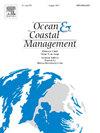漏斗状河口采砂下疏浚坑的长期形态演变与修复
IF 5.4
2区 环境科学与生态学
Q1 OCEANOGRAPHY
引用次数: 0
摘要
在全球范围内,航运和建筑用砂的需求量正以极高的速度增长;许多大型河口都受到了大规模挖沙活动的影响,这对河口的水动力和地貌造成了极大的冲击。伶仃洋河口(LE)近几十年来一直受到大规模采砂的影响,中间滩涂有零星的深采坑。基于最先进的建模工具(TELEMAC),再现了伶仃洋河口 1998-2015 年和 2016-2021 年的长期形态演变,以解释疏浚引起的水深变化。然后,从机理上分析了大规模疏浚对地貌演变的影响。最后,利用长期形态模型评估了中浅滩挖沙坑的地貌恢复情况。在 2012-2015 年期间,大规模采砂改变了中浅滩的沉积状况,从轻微的净沉积模式变为净侵蚀模式。总体而言,从 1998 年到 2015 年,航道疏浚和采砂都显著增加了内 LE(ILE)的侵蚀;2012-2015 年采砂造成了 64% 的侵蚀,而 1998-2012 年航道疏浚造成了 28% 的侵蚀。与此相反,1998 年至 2015 年期间,航道疏浚和采砂都增加了外侧河谷(OLE)的沉积;2012 年至 2015 年期间的采砂占这些沉积的 44%,而 1998 年至 2012 年期间的航道疏浚占 55%。1998 年至 2015 年期间在 ILE 进行的大规模疏浚导致潮汐作用加强,是这一时期造成 ILE(中浅滩巨大沙坑周围)沉积物夹带的主要因素。此外,航道疏浚导致西航道的水流分流率增加,从而导致沉积物在 OLE 中迁移和沉积;它还支持了中浅滩和西航道之间过渡带的沉积作用。最后,从 2016 年到 2021 年,大规模采砂引起了中浅滩地貌的变化,需要≥50 年的时间才能在自然条件下恢复;到 2100 年,中浅滩这些挖沙坑的形态预计无法恢复到 2012 年的形态。该研究结果全面阐明了河口水动力和形态对疏浚的长期响应,为河口管理提供了科学依据。本文章由计算机程序翻译,如有差异,请以英文原文为准。
Long-term morphological evolution and restoration of dredged pits under sand mining in a funnel shaped Estuary
Globally, the demand for shipping and construction-grade sand is increasing at a very high rate; many large estuaries are affected by large-scale dredging, which dramatically impacts estuarine hydrodynamics and geomorphology. Lingdingyang Estuary (LE) has been subjected to large-scale sand mining in recent decades with scattered deep mined pits in the middle shoal. Based on a state-of-the-art modeling tool (TELEMAC), the long-term morphologic evolution of the LE in 1998–2015 and 2016–2021 was reproduced to explain dredging-induced bathymetric changes. Then, the influences of massive dredging on geomorphic evolution were mechanistically analyzed. Finally, geomorphic restoration of the sand dredged pits in the Middle Shoal was evaluated using the long-term morphologic model. Large-scale sand mining changed the sedimentation condition of the Middle Shoal from a slight net deposition pattern to a net erosion pattern in 2012–2015. Overall, both channel dredging and sand mining significantly increased erosion in the inner LE (ILE) from 1998 to 2015; sand mining in 2012–2015 contributed 64% for these erosion, whereas channel dredging accounted for 28% in 1998–2012. In contrast, both channel dredging and sand mining increased deposition in the outer LE (OLE) from 1998 to 2015; sand mining in 2012–2015 contributed 44% for these deposition, whereas channel dredging accounted for 55% in 1998–2012. Strengthened tidal forcing, induced by massive dredging in the ILE from 1998 to 2015, was the dominant factor driving sediment entrapment in the ILE (around huge sand pits in the Middle Shoal) during this period. Additionally, channel dredging induced an increase in flow diversion rate in the Western Channel, which led to sediment transport and deposition in the OLE; it also supported sedimentation in the transition zone between the Middle Shoal and Western Channel. Finally, massive sand mining induced variations in geomorphology in the Middle Shoal from 2016 to 2021 that will require ≥50 years to recover under natural conditions; by 2100, the morphologies of these sand dredged pits in the Middle Shoal are not expected to be restored into their morphologies in 2012. The results of this study comprehensively elucidate the responses of long-term estuarine hydrodynamics and morphology to dredging and provide scientific basis for estuarine management.
求助全文
通过发布文献求助,成功后即可免费获取论文全文。
去求助
来源期刊

Ocean & Coastal Management
环境科学-海洋学
CiteScore
8.50
自引率
15.20%
发文量
321
审稿时长
60 days
期刊介绍:
Ocean & Coastal Management is the leading international journal dedicated to the study of all aspects of ocean and coastal management from the global to local levels.
We publish rigorously peer-reviewed manuscripts from all disciplines, and inter-/trans-disciplinary and co-designed research, but all submissions must make clear the relevance to management and/or governance issues relevant to the sustainable development and conservation of oceans and coasts.
Comparative studies (from sub-national to trans-national cases, and other management / policy arenas) are encouraged, as are studies that critically assess current management practices and governance approaches. Submissions involving robust analysis, development of theory, and improvement of management practice are especially welcome.
 求助内容:
求助内容: 应助结果提醒方式:
应助结果提醒方式:


